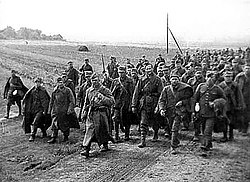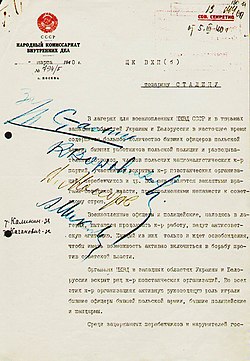In Germany
Invasion of Poland


During the German invasion of Poland, which started World War II, hundreds of thousands of Polish soldiers became prisoners of war. During the invasion, Nazi Germany carried out a number of atrocities involving Polish prisoners of war (POWs). [2] : 28 Historians have identified over sixty instances of Polish prisoners being shot in captivity. [6] : 121 [2] : 30 The first documented massacres of Polish POWs took place as early as the first day of the war; [7] : 11 others quickly followed (ex. the Serock massacre of 5 September). [8] : 31 [9] During that period, the Wehrmacht is estimated to have mass-murdered at least 3,000 Polish POWs, [6] : 121 [10] : 241 with the largest atrocities being the Ciepielów massacre of 8 September 1939 (~300 victims [2] : 29 ) and the Zambrów massacre of 13–14 September (~200 victims). [9] Most of those atrocities are classified as war crimes of the Wehrmacht. [9]
As a prelude to The Holocaust, Polish POWs of Jewish origin were routinely selected and shot on the spot. [9] [11] Those who survived were imprisoned with the other soldiers, but eventually separated from the ethnic Poles through racial screenings. [2] : 297–301 In December 1939 the German military authorities initiated the process of releasing the Jewish privates and NCOs from Stalags. When Operation Reinhard commenced, they shared the same fate as other Jews. [12] Only the fate of the Jewish officers was different. They remained in Oflags and majority of them survived the war. [13] : 236
German atrocities against Poles have been explained due to widespread historical anti-Polish sentiment among the Germans, encouraged by Nazi propaganda, which described Poles as German-hating Untermenschen . Wehrmacht communiqués warned soldiers against the alleged "fanatic" hatred of Poles towards the Germans and warned them to expect guerrilla warfare, sabotage and diversion. In particular, German officers often treated Polish soldiers of disorganized units captured behind German lines as partisans, not as regular soldiers, and felt justified in ordering their summary executions; similar treatment befell members of the Polish paramilitary formations and ad-hoc citizens watches formed before and during the campaign to aid the Polish army. This has been compounded by the lack of preparation, resources, and will to secure surrendered Polish soldiers. [9] [14] : 13 [2] : 31 [15] : 65–66, 90–92 German atrocities against Polish POWs have been discussed in the context of German later and even more extreme atrocities against Soviet POWs, as setting the stage for them. [2] : 27–28, 483 [8] : 34 [16] : 179–185 They have also led a number of historians to conclude that Germany violated the Geneva convection from early days of the war. [7] : xv–xvi [17] [2] : 30, 32–33 [16] : 179–185
Camps and forced labor

Polish POWs were initially held in temporary camps; conditions in them have been described as "dreadful"; some Polish prisoners were billeted in the open as late as December. [2] : 32–33 Within months, the soldiers were moved to more permanent ones (Oflags for officers and Stalags for soldiers of lower ranks); with officers given the expected preferential treatments (relocated faster and to permanent, comparatively better conditions). [2] : 33–34, 36 The Poles were split between over twenty Stalags and eight Oflags. [2] : 33–34 Some of the major locations for Oflags hosting Polish POWs (over 20,000 officers, including 46 generals) were Oflag VI-B (Déssel, Belgium), Oflag VII-A (Murnau, Germany), Oflag II-E (Neubrandenburg, Germany), Oflag II-C (Woldenburg, Germany, now Poland), Oflag II-D (Gross Born, Germany, now Poland), and Oflag VI-G (Emslandlager Oberlangen , Oberlangen, Germany). [2] : 36 Polish soldiers captured later in the war were often grouped with Western soldiers, based on their uniforms. [2] : 37–38
Conditions of Polish POWs have been described as "much worse" than those of Western Allies. [18] [8] : 34 [2] : 32–33, 36–37 Food rations were inadequate. [2] : 33–34 Religious services were held, but with no confessions allowed for security reasons. [2] : 33–34 Some prisoners died due to malnutrition and environmental conditions; [2] : 34–35 for example in January 1940 a group of 2,000 sick POWs were decreed to be released and transported from Germany to Poland; however, a tenth of them have frozen to death during the transport. [8] : 34

Many Polish POWs were used as forced laborers. [8] : 35 [2] : 10 Within several months, almost all non-officer prisoners of war (estimates range at 300,000–480,000) were stripped of their POW status and forced to work in Nazi Germany. [19] [2] : 38–40 The Germans already assigned 300,000 Polish POWs for agricultural duties to help with the '39 harvest, and made arrangements for forced labor of POWS as early as January that year. [2] : 38–40 A year later, it was estimated that between 344,000 and 480,000 Polish POWs were working in the German economy. [2] : 38–40 Most of them were "civilianized" – released from POW camps, then immediately forced to sign labor contracts; this made them technically ineligible for protection from the Geneva Convention. After that, the number of Polish POWs in German was reduced to 80,000 officers, NCOs, and other groups deemed unfit or unwanted in the labor force (intelligentsia, minorities including Jews, and several other categories). [2] : 38–40
A few dozen Polish officers were executed after having been recaptured during the failed escape attempt in 1943 from the Oflag VI-B. [8] : 36 [2] : 37 Others died in massacres of POWs in the Eastern Front; for example in February 1945, during the breakthrough of the Pomeranian Wall, approximately 150–200 POWs were executed by the Germans in Podgaje, an event known as the Podgaje massacre of 2 February 1945. [20] : 23 [21] Another large massacre took place following the Battle of Bautzen in April 1945, when Wehrmacht soldiers massacred the hospital column of the Polish 15th Sanitary Battalion, resulting in the deaths of around 300 POWs, including wounded soldiers and members of the medical personnel (the Horka massacre ). [22]

